| FLAG FRAMING |
 |
|
Framing is one of the best ways to respectfully and professionally display a flag in your space or home. No matter if it's a brand new banner of your favourite sports team, a vintage gift from the days of yore, or a custom-dye-sublimated piece, there are many different methods to framing flags that will allow you to both showcase your piece, as well as preserve it for years to come.
This article explains the different methods in which flags can be framed or displayed, some tips on mounting and caring for your flags, as well as some general information regarding their material and production process.
If you want to start by ordering a custom-printed sheet of fabric to transform into a flag, visit our Fabric Printing page.
And if you're looking to frame your flag in either a Shadow-Box or traditional frame, view our entire moulding selection here article.
|
| STANDARD METHODS OF HANGING
|
 |
|
There are several different ways to traditionally frame a flag:
1) Folded
Triangle-folded flags are one of the most traditional ways to frame a flag. It is usually placed in a Shadow-Box or Flag Case, preferably with UV protective glass or plexiglass and archival foam board.
Please note that this method is typically used for memorial events, not for celebratory displays.
2) Unfurled
If you have the wall space to display the flag in its entirety, you will need a much larger case or frame to protect it. You can present an unfurled flag by hanging it in a Shadow-Box, or pressed between glass and the backing in a traditional frame.
3) Matted
Smaller flags look especially good when they are paired with single or double-layered matboards. Matboards can add space, color, and areas for supporting information, such as labels, titles, or other related memorabilia.
Framed flags can be presented in many ways and combinations. Make sure to layout a draft of your items before purchasing your matboard. Mats are also available in archival or conversation quality, to protect the fibres of the flag from discoloration or micro-degradation over time.
|
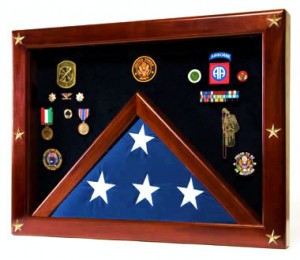
An example of a triangle folded flag, in a customized frame with divisions.

Shadow Boxes are excellent ways to traditionally frame unfurled flags.
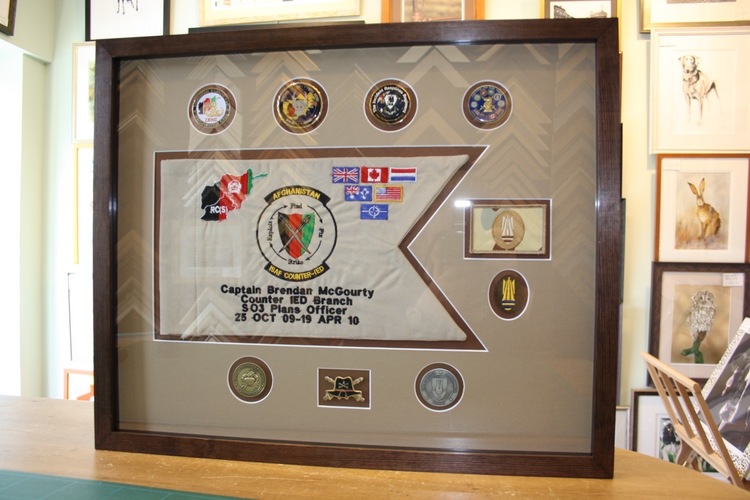
Framing a flag with a matboard allows you to have more space for customization.
|
| ADHERING OR MOUNTING YOUR FLAG
|
 |
|
If you're going to frame your flag in a Shadow Box, it can be mounted in different ways. Below are several fastening suggestions. Most are invisible, and will allow you disassemble and rearrange your contents if need be, with no damage to the items.
| NAME |
IMAGE |
PROCESS |
| Clear Glue Dots |
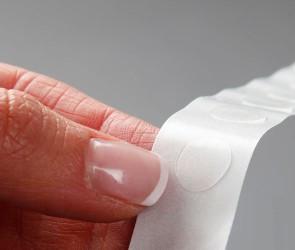 |
Works for light objects -- foam, paper, plastic, metal, some fabrics, wood and glass. They require no drying time, are removable and can't be seen. One of the easier fastening methods./TD>
|
| Clear Monofilament Thread |
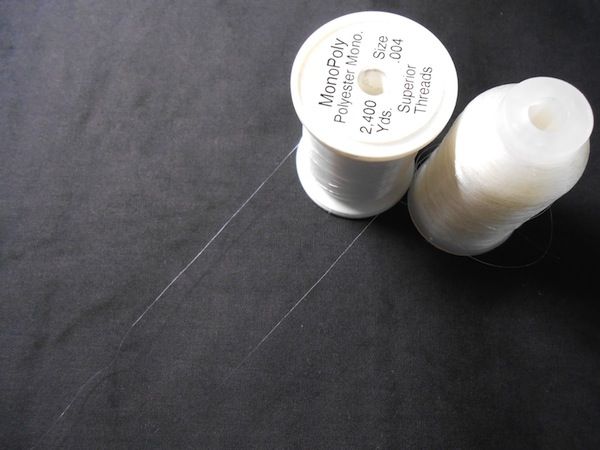 |
Works for delicate or sturdy items. Secures flag invisibly by stitching it in place. Easy to remove by snipping the threads when needed. When buying the thread, make sure to check the weight it can safely hold. |
| Glue Gun |
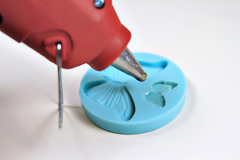 |
Works best for harder, heavier objects made of either wood or metal. Messy and more permanent; can cause damage when removing. |
| Double-Sided Sticky Tape |
 |
Works best for light, fine materials that are not so valuable. Though the adhesive is not as strong, it can be difficult to clean, which may incur damage when removing. |
| Pins |
 |
Easy to apply, but must be paired with thick foam backings that can secure it. Make sure pins are rust-free, stainless, and smooth (dressmaker-quality) to prevent discoloration or snagged threads. |
|
| ALTERNATIVE WAYS TO DISPLAY FLAGS
|
 |
|
If preserving a flag is not your goal, there are many other creative ways to display your flag. However, most of them will not provide the protection and durability that framing will provide.
Stretching Flags
Like canvas prints, flags can be stretched over internal wooden frames (called stretcher frames). The final product looks clean, polished and presentable, and ready to hang. Additional floater frames can be added on afterwards for an even more commemorative effect.
However, in order to keep the fabric flat and taut, the ends of the flag must be stretched around the edge and stapled to the back of the wooden frames. This means that about 1"- 2" of flag will be lost around the edges (or in other words, that your completed flag size will be about 1"-2" smaller from all sides). For some flags, this may not be an issue (such as when most of the graphic is centered in the middle), but for others it can be problem (such as starry corners, borders along the edges, etc).
Hanging Flags
Hanging flags from dowels are now quite common in bedrooms and kitchens. To do this, simply slide a dowel where the string would normally be slipped through. This means your flag will hang vertically rather than horizontally, but it can give an impressive banner-like effect.
If you prefer to hang your flags vertically without sewing a loop for the dowel, you can also adhere them to a strip of wood. This will allow your flag to hang freely, horizontally, and easy to mount on the wall.
Floating Acrylic Frames
Floating Acrylic Frames are popular due to their minimal and modern appearance. Since they connected by a screw in each corner, they do not need any framing on the edges. Like prints, flags can be slotted in between the two acrylic sheets, and pressed shut by the screws to give the impression it is "floating" in the air. Because fabric is much thicker than paper, the pressure needed on the screws is much higher, and thus this is not the best recommended framing solution for flags.
|

Much like how canvas prints or paintings are streched over an interal frame, flags can also be displayed in this way.

Flags can also be hung from dowels for a more free-form look.
|
| PROPER CARE OF A FLAG
|
 |
|
The age and material of your flag can influence the type of framing or mounting method that is needed. If you suspect you may have a vintage flag, take it to your nearest museum to have a textile conservator review it for you before framing.
Older flags can also come in materials such as canvas, burlap, or cotton. Although all flags should be kept out of direct sunlight, silk flags are the most delicate, and deteriorate the quickest. To prevent this, make sure your plexiglass or acrylic is UV-resistant. Matboards should be rag mat as the calcium-carbonate buffers in standard matboards can be harsh on silks.
|
| PRINTNG CUSTOM-MADE FLAGS
|
 |
|
Flags are usually printed by one of three methods: Silk Screening, Digital Printing or Dye-Sublimated Printing.
Silk-Screening Silk Screening is a process in which layers of ink are pushed through a stencil to create a print. The fabric and ink are heat-treated to improve the fibres' durability. Because the ink can be custom mixed, silk-screening also allows for a higher degree of color accuracy. However, the initial preparation is extremely laborious, and thus most screen-printers will only print in volumes higher than 10. Silk-screening also does not allow for extremely detailed work, as every part of the image is created by cutting out stencils. Thus, it is best for graphics with simple vector work, not for photographic details.
Digital Printing Digital Printing refers to the ability to print to a material that is fed through a printer. Most digital printers are limited to printing on paper only, but some are able to print on certain types of fabric, wood, or glass. These kinds of digital printers will usually call themselves "Direct To" digital printing, to differentiate themselves from basic paper-only printers and other dye-sublimated printers.
Digital Flag Printing, therefore, is the process in which the fabric for the flag is fed through the printer and the image is printed by nozzles of colour. Because the ink cannot penetrate through the fibres as thoroughly as screen-printing, digitally-printed graphics will usually be lighter in color on the reverse side. Thus, most digitally-printed double-sided flags are actually made of two single pieces sewn back to back. Although this may sound inconvenient, digital flag-printing has less upstart preparation involved, and thus no minimum order requirements. You could digitally print 1 fl/ag or 7 flags or more, and all on demand. Digital printers also are capable of printing in more resolution and detail. At KeenArt Media, we can do digitally printed-flags by printing on our Satin Banner material.
Dye-SublimatedDye-Sublimated printing is probably one of the most popular, low-cost and modern way to print flags. The process allows you to combine the best of both worlds: the richness in color from silk-screening with the photographic abilities of digital printing. Instead of being printed directly onto the fabric, the image is printed onto transfer paper first. It is then pressed against the flag material (must be polyester) and both are placed in a heat press at 375 degrees. At this temperature, the inks transform to gases, which permeate and re-solidify into the flag's fibres. This allows a much more thorough and permanent penetration of color, which is resistant against fading even after multiple washes. The Dye-Sublimated process has no order limitations, and is therefore the most flexible option for fabric printing. Here at KeenArt, we also offer one-sided dye-sublimated flag printing.
|

A snapshot of the silk-screening process.
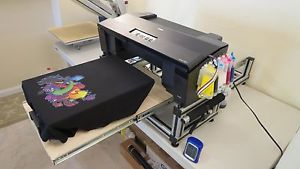
This direct-to-garment printer prints ink directly onto the fabric that's been spread on a base beneath the nozzles.

After the image is transfered into fabric via dye-sublimation, it needs to be cut and hemmed to ensure that the polyester ends don't fray.
|
| MATERIALS OF FLAGS
|
 |
When it comes to making flags, material matters. Modern flags are usually made of the following fabrics:
- Knitted polyester: This is the most popular modern material for flags. It can be digitally or screen printed or dye-sublimated. It also is light enough to create a nice "wave motion" in the wind.
- Woven/Spun polyester: This is the most durable material for making flags, and is used as a base material for additional embroidery or applique. It is not usually digitally printed as the inks are not able to penetrate through the fibres, causing weak color on the reverse side.
- Decotex 205gsm: A heavier-weight knitted polyester that is more durable. Designed for flags that are reversible, or those hung from angled flag poles.
- Specialist Materials:For special occasions, other materials can be used to make flags, such as Satin, Mesh, Voile, etc. These are mostly for ceremonial purposes where a specific look needs to be achieved (glossy, soft, etc), and are not usually used for flying outdoors.
|
|
© 2002-2025 - KeenART Media Ltd.
|
|
| |
|

